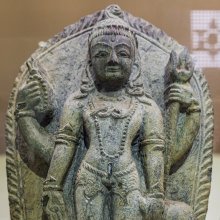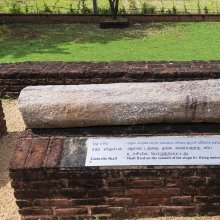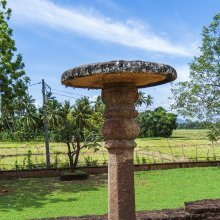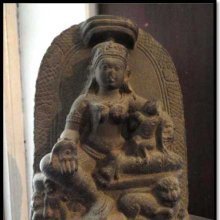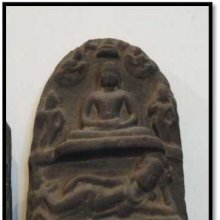Chatra, Chātra, Chatrā, Chātrā: 24 definitions
Introduction:
Chatra means something in Buddhism, Pali, Hinduism, Sanskrit, Jainism, Prakrit, the history of ancient India, Marathi, Hindi. If you want to know the exact meaning, history, etymology or English translation of this term then check out the descriptions on this page. Add your comment or reference to a book if you want to contribute to this summary article.
Alternative spellings of this word include Chhatra.
Ambiguity: Although Chatra has separate glossary definitions below, it also represents an alternative spelling of the word Catra. It further has the optional forms Chātra.
Images (photo gallery)
(+6 more images available)
In Hinduism
Shilpashastra (iconography)
Source: Red Zambala: Hindu Icons and Symbols | IntroductionChatra (छत्र, “the parasol”).—In Indian culture only high dignitaries were allowed the use of a parasol the largest ones usually white were reserved for the king and for the gods. The larger the number of smaller parasols heaped above the main one, the higher the personage represented. Thus in Indian culture the parasol is a symbol of spiritual power.

Shilpashastra (शिल्पशास्त्र, śilpaśāstra) represents the ancient Indian science (shastra) of creative arts (shilpa) such as sculpture, iconography and painting. Closely related to Vastushastra (architecture), they often share the same literature.
Purana and Itihasa (epic history)
Source: archive.org: Shiva Purana - English Translation1) Chatra (छत्र) refers to the “umbrella” which forms part of the royal paraphernalia (mahārājopacāra), according to the Śivapurāṇa 2.2.28. Accordingly as Brahmā narrated to Nārada:—“[...] Lord Śiva, possessed of the perfect vision, realising everything and seeing all, and the cause of protection, being requested by the Goddess, spoke to her:—‘[...] You can go in royal splendour mounting this bull richly caparisoned’. Satī thus commanded to mount the decorated bull, bedecked herself and started for her father’s abode. The royal paraphernalia (mahārājopacāra) like the umbrella (chatra), chowries, silken clothes and ornaments were given to her by (Śiva) the great lord”.
2 ) Chatra (छत्र) refers to the “umbrella” (of a chariot), according to the Śivapurāṇa 2.5.8 (“The detailed description of the chariot etc.”).—Accordingly, as Sanatkumāra narrated to Vyāsa: “The divine chariot of lord Śiva consisting of all the worlds was built by Viśvakarman with devoted effort. [...] Lord Brahmā was the charioteer, the gods were holders of the bridle. Praṇava the Vedic divinity constituted the long whip of Brahma. The syllable A constituted the great umbrella (maha-chatra) [akāraśca mahacchatraṃ], Mandara the side staff. The lord of mountains became his bow and the lord of serpents the bowstring. [...]”
Source: Cologne Digital Sanskrit Dictionaries: The Purana Index1a) Chatra (छत्र).—The seven worlds, white in colour, are one above the other umbrella-like.*
- * Brahmāṇḍa-purāṇa II. 21. 19; III. 49. 23; 55. 15; IV. 37. 35.
1b) The white umbrella as insignia of royalty given to Kāmeśvara by Viṣṇu; lofty as the sky.1 Kauravas threatened Ugrasena to deprive him of that.2
Source: Shodhganga: The saurapurana - a critical studyChatra (छत्र) refers to one of the various kinds of articles used for donation, according to the 10th century Saurapurāṇa: one of the various Upapurāṇas depicting Śaivism.—Accordingly, the tenth chapter contains the praise and classification of donations. It narrates the characteristics of proper recipients and the results of giving different kinds of articles like Bhūmi, Vidyā, Anna, Jala, Tila, Vāsa, Dīpa, Yāna, Śayyā, Dhānya, Aśva, Śāka, Indhana, Chatra, Auṣadha, Go, etc.

The Purana (पुराण, purāṇas) refers to Sanskrit literature preserving ancient India’s vast cultural history, including historical legends, religious ceremonies, various arts and sciences. The eighteen mahapuranas total over 400,000 shlokas (metrical couplets) and date to at least several centuries BCE.
Pancaratra (worship of Nārāyaṇa)
Source: Wisdom Library: PāñcarātraChatra (छत्र) refers to an aspect of nṛsiṃha (‘man-lion’), according to the Vihagendra-saṃhitā 4.17, which mentions seventy-four forms (inlcuding twenty forms of vyūha). He is also known as Chatranṛsiṃha or Chatranarasiṃha. Nṛsiṃha is a Tantric deity and refers to the furious (ugra) incarnation of Viṣṇu.
The 15th-century Vihagendra-saṃhīta is a canonical text of the Pāñcarātra corpus and, in twenty-four chapters, deals primarely with meditation on mantras and sacrificial oblations.

Pancaratra (पाञ्चरात्र, pāñcarātra) represents a tradition of Hinduism where Narayana is revered and worshipped. Closeley related to Vaishnavism, the Pancaratra literature includes various Agamas and tantras incorporating many Vaishnava philosophies.
Ayurveda (science of life)
Nighantu (Synonyms and Characteristics of Drugs and technical terms)
Source: WorldCat: Rāj nighaṇṭu1) Chatrā (छत्रा) is another name for Śatāhvā, an unidentified medicinal plant, according to verse 4.10-13 of the 13th-century Raj Nighantu or Rājanighaṇṭu. The fourth chapter (śatāhvādi-varga) of this book enumerates eighty varieties of small plants (pṛthu-kṣupa). Also see the description of the plant Miśreyā. Together with the names Chatrā and Śatāhvā, there are a total of twenty-four Sanskrit synonyms identified for this plant.
2) Chatrā (छत्रा) is also mentioned as a synonym for for Miśreyā, an unidentified medicinal plant possibly identified with Foeniculum vulgare (synonym Foeniculum capillaceum) or “fennel”, from the Apiaceae (Umbelliferae) or “carrot family” of flowering plants, according to verse 4.14-19. Also see Śatāhvā. Together with the names Chatrā and Miśreyā, there are a total of fifteen Sanskrit synonyms identified for this plant.
Dietetics and Culinary Art (such as household cooking)
Source: Shodhganga: Dietetics and culinary art in ancient and medieval IndiaChātra (छात्र) refers to one of the eight kinds of honey (madhu) according to the Suśrutasaṃhitā Sūtrasthāna 45.133, and is commonly found in literature dealing with the topics of dietetics and culinary art, also known as Pākaśāstra or Pākakalā.—Honey was possibly, the earliest sweet thing Indians knew. [...] According to Suśruta the eight varieties of honey are mākṣika, bhrāmara, kṣaudra, pauttika, chātra, ārghya, auddalika and dāla each of these being obtained from different types of bees.

Āyurveda (आयुर्वेद, ayurveda) is a branch of Indian science dealing with medicine, herbalism, taxology, anatomy, surgery, alchemy and related topics. Traditional practice of Āyurveda in ancient India dates back to at least the first millenium BC. Literature is commonly written in Sanskrit using various poetic metres.
Shaivism (Shaiva philosophy)
Source: Google Books: Manthanabhairavatantram (shaivism)Chatra (छत्र) (Cf. Pīṭha) refers to an “umbrella”, according to the Niḥśvāsatattvasaṃhitā, one of the most ancient of extant Śaiva Tantras.—Accordingly, “Having offered a seat (pīṭha), umbrella [i.e., chatra], turban and knife, (one should say): ‘You are the teacher, Śiva's equal; exercise (your) grace in the world’.”.

Shaiva (शैव, śaiva) or Shaivism (śaivism) represents a tradition of Hinduism worshiping Shiva as the supreme being. Closely related to Shaktism, Shaiva literature includes a range of scriptures, including Tantras, while the root of this tradition may be traced back to the ancient Vedas.
Jyotisha (astronomy and astrology)
Source: Wisdom Library: Brihat Samhita by VarahamihiraChatra (छत्र) refers to a “(royal) umbrella”, according to the Bṛhatsaṃhitā (chapter 3), an encyclopedic Sanskrit work written by Varāhamihira mainly focusing on the science of ancient Indian astronomy astronomy (Jyotiṣa).—Accordingly, “The dark spots, also known as ketus, the sons of Rāhu are Tāmasa, Kīlaka and the like, and are 33 in number. How they affect the earth depends upon their color, position and shape. [...] If the solar spots should be of the shape of the emblems of royalty such as chatra (umbrella), dhvaja (flag staff) and cāmara (hairy fan) and the like, the reigning prince will be dethroned and a foreign prince will begin to reign. If the spots should appear like sparks of fire, like the smoke and the like, his subjects will suffer”.

Jyotisha (ज्योतिष, jyotiṣa or jyotish) refers to ‘astronomy’ or “Vedic astrology” and represents the fifth of the six Vedangas (additional sciences to be studied along with the Vedas). Jyotisha concerns itself with the study and prediction of the movements of celestial bodies, in order to calculate the auspicious time for rituals and ceremonies.
Vastushastra (architecture)
Source: Shodhganga: Elements of Art and Architecture in the Trtiyakhanda of the Visnudharmottarapurana (vastu)Chatra (छत्र) refers to one of the hundred types of Temples (in ancient Indian architecture), according to the Viṣṇudharmottarapurāṇa, an ancient Sanskrit text which (being encyclopedic in nature) deals with a variety of cultural topics such as arts, architecture, music, grammar and astronomy.—It is quite difficult to say about a definite number of varieties of Hindu temples but in the Viṣṇudharmottarapurāṇa hundred varieties of temples have been enumerated. For example, Chatra. These temples are classified according to the particular shape, amount of storeys and other common elements, such as the number of pavilions, doors and roofs. [...] The Viṣṇudharmottarapurāṇa relates that the temple named Chatra should be constructed in the shape of a umbrella.

Vastushastra (वास्तुशास्त्र, vāstuśāstra) refers to the ancient Indian science (shastra) of architecture (vastu), dealing with topics such architecture, sculpture, town-building, fort building and various other constructions. Vastu also deals with the philosophy of the architectural relation with the cosmic universe.
In Buddhism
Mahayana (major branch of Buddhism)
Source: academia.edu: A Study and Translation of the GaganagañjaparipṛcchāChatra (छत्र) refers to “(showering) parasols”, according to the Gaganagañjaparipṛcchā: the eighth chapter of the Mahāsaṃnipāta (a collection of Mahāyāna Buddhist Sūtras).—Accordingly, “[...] Then, by the unconditioned magical power of manifestation, by the miraculous performances (vikrīḍita) of the Buddha [Ekaratnavyūha], [Gaganagañja with the other Bodhisattvas] teleported from the Mahāvyūha universe to the Sahā universe, in one moment of thought, and sat down there. They showered flowers, garlands, powders, perfumes, unguents, parasols (chatra), banners, flags from the Mahāvyūha universe pouring down as rain”

Mahayana (महायान, mahāyāna) is a major branch of Buddhism focusing on the path of a Bodhisattva (spiritual aspirants/ enlightened beings). Extant literature is vast and primarely composed in the Sanskrit language. There are many sūtras of which some of the earliest are the various Prajñāpāramitā sūtras.
Tibetan Buddhism (Vajrayana or tantric Buddhism)
Source: Brill: Śaivism and the Tantric Traditions (tantric Buddhism)Chatra (छत्र) refers to a “parasol”, according to the Bhūśalyasūtrapātananimittavidhi section of Jagaddarpaṇa’s Ācāryakriyāsamuccaya, a text within Tantric Buddhism dealing with construction manual for monasteries etc.—Accordingly, “[...] If a parasol (chatra), lotus, banner, muraja drum, flagpole, ornament, a woman of the court, fish, milk, the best curd, wine, blazing fire, and fruits [are seen], then there are victory, extraordinary increase of grain, property, [the number of] sons, and other [merits], and the completion of duties. [...]”.

Tibetan Buddhism includes schools such as Nyingma, Kadampa, Kagyu and Gelug. Their primary canon of literature is divided in two broad categories: The Kangyur, which consists of Buddha’s words, and the Tengyur, which includes commentaries from various sources. Esotericism and tantra techniques (vajrayāna) are collected indepently.
General definition (in Buddhism)
Source: WikiPedia: BuddhismOne of the Eight Auspicious Symbols.—The Precious Parasol (Sanskrit: Chatra) or Sacred Umbrella which is similar in ritual function to the baldachin or canopy. Muller Ebeling, Ratsch & Shahi (2002) scholarly chart the origins of the Sacred Parasol as a symbolic depiction of sacred medicinal and hallucinogenic mushrooms of the Himalayan pharmacopeia; representing the protection of beings from harmful forces, illness; represents the canopy or firmament of the sky and therefore the expansiveness and unfolding of space and the element aether; represents the expansiveness, unfolding and protective quality of the sahasrara; under the auspice of the precious parasol all take refuge in the Dharma;
In Jainism
General definition (in Jainism)
Source: Wisdom Library: JainismChatrā (छत्रा) is the name of the caitya-tree under which the parents of Padmaprabha are often depicted in Jaina iconography, according to the Digambara tradition. According to the Śvetāmbara tradition the tree is known as Caturābha (identified with Anethum sava). The term caitya refers to “sacred shrine”, an important place of pelgrimage and meditation in Jainism. Sculptures with such caitya-trees generally shows a male and a female couple seated under a tree with the female having a child on her lap. Usually there is a seated Jina figure on top of the tree.
Padmaprabha is the sixth of twenty-four tīrthaṅkaras: enlightened beings who, having conquered saṃsāra (cycle of birth and death), leave a path behind for others to follow. His father is Dhara according to Śvetāmbara but Dharaṇa according to Digambara and his mother is Susīmā, according to the Ācāradinakara (14th century work on Jain conduct written by Vardhamāna Sūri).
Source: Google Books: Jainism: An Indian Religion of SalvationChatra (छत्र, “sun-umbrella”).—One of the fourteen gems (ratna) serving the Cakravartin;—The chatra is a glittering white sun-umbrella. It is for the Cakravartī not only as a symbol of his dignity as a ruler, but it also cripples his enemy by its look. It protects against rain and sun, against wind and weather and gives cool shade in hot season and a warm shade in cold season.

Jainism is an Indian religion of Dharma whose doctrine revolves around harmlessness (ahimsa) towards every living being. The two major branches (Digambara and Svetambara) of Jainism stimulate self-control (or, shramana, ‘self-reliance’) and spiritual development through a path of peace for the soul to progess to the ultimate goal.
India history and geography
Source: Cologne Digital Sanskrit Dictionaries: Indian Epigraphical GlossaryChatra.—an umbrella; cf. pañcāṅga-prasāda. (EI 27), an attendant or Piāda; cf. Chātra. Cf. Varāha-kṣetra = Barāh-chatra (Sircar, Studies in the Geography of Ancient and Medieval India, p. 221); corruption of Sanskrit kṣetra. Note: chatra is defined in the “Indian epigraphical glossary” as it can be found on ancient inscriptions commonly written in Sanskrit, Prakrit or Dravidian languages.
--- OR ---
Chātra.—(IE 8-3, 8-8; EI 23, 30), cf. a-bhaṭa-cchātra- prāveśya (IE 8-5); literally, ‘one bearing an umbrella’ or ‘the king's umbrella-bearer’; but probably the same as the Cāṭa or the leader of a group of Bhaṭas (Pāiks or Piādas) as in a-cāṭa- bhaṭa-prāveśya; a peon of the law-court. See Chatracchāyika. (CII 3), used in composition with bhaṭa and also singly; literally, ‘an umbrella-bearer’; but actually, a constable like a Pāik or Piāda. (SITI), celebate (Brahmacārin) in charge of a temple and the śālai attached to it; also called Śaṭṭar, Śāttirar. Note: chātra is defined in the “Indian epigraphical glossary” as it can be found on ancient inscriptions commonly written in Sanskrit, Prakrit or Dravidian languages.

The history of India traces the identification of countries, villages, towns and other regions of India, as well as mythology, zoology, royal dynasties, rulers, tribes, local festivities and traditions and regional languages. Ancient India enjoyed religious freedom and encourages the path of Dharma, a concept common to Buddhism, Hinduism, and Jainism.
Languages of India and abroad
Marathi-English dictionary
Source: DDSA: The Molesworth Marathi and English Dictionarychatra (छत्र).—n (S) A large and lofty parasol, usually of red silk. It is an ensign of dignity. 2 A little silver or brass umbrella-form canopy over an idot. 3 fig. Defence, protection, guard. Ex. rājā prajācēṃ chatra; mātāpitā hīṃ mulācēṃ chatra. 4 S An umbrella or a parasol gen., a chattah or chhatri. chatra dharaṇēṃ To hold the chatra over a king or grandee in procession; and, derisively, over a person seated upon an ass in disgrace. Ex. kaikaicēṃ vapana karōnī satvara || tijavarī dharāvēṃ chatra ||. mēghānnīṃ chatra dharilēṃ It is clouding over.
--- OR ---
chātra (छात्र).—m S A disciple or pupil. (From chatra Umbrella or cover; as a scholar must conceal the faults of his teacher.)
Source: DDSA: The Aryabhusan school dictionary, Marathi-Englishchatra (छत्र).—n A large and lofty parasol. Fig. Defence. Protection.
--- OR ---
chātra (छात्र).—m A disciple or pupil.
Marathi is an Indo-European language having over 70 million native speakers people in (predominantly) Maharashtra India. Marathi, like many other Indo-Aryan languages, evolved from early forms of Prakrit, which itself is a subset of Sanskrit, one of the most ancient languages of the world.
Sanskrit dictionary
Source: DDSA: The practical Sanskrit-English dictionaryChatra (छत्र).—A mushroom.
-tram 1 A parasol, an umbrella; अदेयमासीत् त्रयमेव भूपतेः शशिप्रभं छत्रमुभे च चामरे (adeyamāsīt trayameva bhūpateḥ śaśiprabhaṃ chatramubhe ca cāmare) R.3.16; Ms. 7.96.
2) Concealing the fault of one's teacher.
Derivable forms: chatraḥ (छत्रः).
--- OR ---
Chatrā (छत्रा).—A mushroom; Manusmṛti 5.19; V. .176; also छत्राकी-कम् (chatrākī-kam).
See also (synonyms): chatrāka.
--- OR ---
Chātra (छात्र).—[chatraṃ gurorvaiguṇyāvaraṇaṃ śīlamasya Sk.; chatrā° ṇa] A pupil, disciple.
-tram A kind of honey.
Derivable forms: chātraḥ (छात्रः).
Source: Cologne Digital Sanskrit Dictionaries: Shabda-Sagara Sanskrit-English DictionaryChatra (छत्र).—n.
(-traṃ) A parasol, and umbrella, the Indian ch'hattah. f.
(-trā) 1. A kind of fennel, (Anethum sowa.) 2. A pungent seed, coriander. 3. A mushroom. 4. Anise. E. chad to cover, and ṇic and ṣṭran Unadi affixes hrasvaśca; hence the word and its derivatives are also written with a double ta, chatra &c.
--- OR ---
Chātra (छात्र).—m.
(-traḥ) A scholar, a pupil, a disciple, a tyro or novice. n.
(-traṃ) Honey. E. chatra an umbrella, a screen or cover, affix ṇa . chatraṃ guroḥ vaiguṇyāvaraṇaṃ śīlamasya chatrā0 ṇa .
Source: Cologne Digital Sanskrit Dictionaries: Yates Sanskrit-English Dictionary1) Chatra (छत्र):—(traṃ) 1. n. A parasol, umbrella. (trā) f. A kind of fennel; coriander; a mushroom; anise.
2) Chātra (छात्र):—(traḥ) 1. m. A pupil. n. Honey.
Source: DDSA: Paia-sadda-mahannavo; a comprehensive Prakrit Hindi dictionary (S)Chatra (छत्र) in the Sanskrit language is related to the Prakrit words: Chatta, Chattā.
Sanskrit, also spelled संस्कृतम् (saṃskṛtam), is an ancient language of India commonly seen as the grandmother of the Indo-European language family (even English!). Closely allied with Prakrit and Pali, Sanskrit is more exhaustive in both grammar and terms and has the most extensive collection of literature in the world, greatly surpassing its sister-languages Greek and Latin.
Hindi dictionary
Source: DDSA: A practical Hindi-English dictionary1) Chatra (छत्र) [Also spelled chhatra]:—(nm) an umbrella; a cenotaph in honour of some outstanding personality; ~[cchāyā] patronage, protection; ~[dhara/dhārī] an umbrella-bearer; one over whose head an umbrella is borne as a mark of dignity and authority; ~[pati] a king, ruler; [chatrākāra] peltate.
2) Chātra (छात्र) [Also spelled chhatra]:—(nm) a student; -[anuśāsana] student discipline; -[anuśāsanahīnatā] student indiscipline; -[āṃdolana] student agitation; student movement; ~[tva] studentship; -[netā] a student leader; ~[vṛti] scholarship.
...
Kannada-English dictionary
Source: Alar: Kannada-English corpusChatra (ಛತ್ರ):—[noun] a building where shelter (sometimes food also) provided benevolently to people, esp. wayfarers.
--- OR ---
Chatra (ಛತ್ರ):—
1) [noun] = ಛತ್ರಿ [chatri]2.
2) [noun] an umbrella-like shade held for a deity or king in a procession, as a symbol of dignity.
3) [noun] any of various rapidly growing, fleshy fungi, typically having a stalk capped with an umbrellalike top; mushroom.
4) [noun] (astrol.) an instance of all the planets being in the house of birth and other six houses from seventh to twelfth, at the time of one’s birth.
--- OR ---
Chātra (ಛಾತ್ರ):—[noun] a boy who is enrolled for study at a school, college, etc. for studying a course; a student.
Kannada is a Dravidian language (as opposed to the Indo-European language family) mainly spoken in the southwestern region of India.
See also (Relevant definitions)
Starts with (+42): Chaatragan, Chatra-abhoga, Chatra-yashti, Chatrabandha, Chatrabha, Chatrabhadrishtimandala, Chatrabhanga, Chatrabhava, Chatracakra, Chatracamara, Chatracchayika, Chatrachatra, Chatrachaya, Chatradarshana, Chatradhanya, Chatradhara, Chatradharana, Chatradharin, Chatradharini, Chatragana.
Ends with (+33): Adhichatra, Ahicchatra, Ahichatra, Akriticchatra, Anantacchatra, Annacchatra, Annachatra, Apacchatra, Aticchatra, Atichatra, Avaricchatra, Barahachatra, Bhumichatra, Cchatra, Chatrachatra, Chatraticchatra, Chatratichatra, Chayachatra, Dharmachatra, Dhavala-cchatra.
Full-text (+100): Chatta, Aticchatra, Chatrabhanga, Chatradhara, Chatraka, Navachatra, Chatraganda, Chatradarshana, Chatrapatra, Chatrapati, Chatrin, Chatracakra, Chatraticchatra, Gomayachatra, Sarpachatra, Gomayacchatra, Chatrika, Sitachatra, Chatradharana, Ahicchatra.
Relevant text
Search found 39 books and stories containing Chatra, Chātra, Chatrā, Chātrā, Chaatra; (plurals include: Chatras, Chātras, Chatrās, Chātrās, Chaatras). You can also click to the full overview containing English textual excerpts. Below are direct links for the most relevant articles:
Satirical works of Kshemendra (study) (by Arpana Devi)
5.19. The Student (chātra) < [Chapter 5 - Kṣemendra’s objectives of Satire]
2. Summary of the Deśopadeśa < [Chapter 3 - Satirical Works of Kṣemendra]
Garga Samhita (English) (by Danavir Goswami)
Verse 6.16.23 < [Chapter 16 - Seeing Śrī Rādhā’s Form]
Verse 5.16.16 < [Chapter 16 - Comforting Sri Radha and the Gopis]
Verse 1.9.4 < [Chapter 9 - Description of Vasudeva’s Wedding]
Stupas in Orissa (Study) (by Meenakshi Chauley)
The Chatravali Portion (of the Stupa) < [Chapter 4]
Stupa at Sanchi < [Chapter 3]
History of Indian Medicine (and Ayurveda) (by Shree Gulabkunverba Ayurvedic Society)
Chapter 5 - Admission to Studies < [Part 2-3 - Medical Institutions in Ancient India]
Amarakoshodghatana of Kshirasvamin (study) (by A. Yamuna Devi)
Education (2): Students < [Chapter 4 - Cultural Aspects]
Daily Life (1): Food and Drinks < [Chapter 3 - Social Aspects]
Impact of Vedic Culture on Society (by Kaushik Acharya)
1.F: The Expression of Charity in Modern Age < [Chapter 2]

